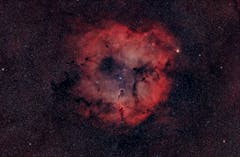Astronomik SII 12nm CCD MaxFR 36mm
MaxFR Astronomik photographic narrowband-emission line filters for fast optical systems.
There is an ever-growing demand for filters suitable for extremely fast optical systems like Celestron’s RASA or the Epsilon Astrographs made by Takahashi.
Our novel MaxFR emission line filters are ideal for very fast focal ratios. The new Astronomik MaxFR series of narrowband-emission line filters is perfectly matched to the needs of astronomical deep-sky imaging with fast optical systems. You may select your filters either with 12nm or 6nm Bandwidth (FWHM) for the three most important emission lines: oxygen (OIII), hydrogen (H-alpha), and sulfur (SII).
Highest transmission:
Our new MaxFR filters are made with an entirely new design, optimized for fast optical systems. The well-known MFR Coating technology ensures excellent out-of-band blocking, covering the full wavelength range from UV to IR! The new design delivers extremely high contrast, reduced stray light, no halos, and pinpoint stars. Astronomik MFR narrowband-emission line filters provide the best quality data for producing outstanding final images!
- For 12nm MaxFR filters: They are usable from f/1.7 to f/8, providing about 85% of maximum transmission at f/1.4 as guaranteed.
- For 6nm MaxFR filters: They work from f/2.2 to f/8, with about 90% of maximum transmission at f/2, ensuring top performance.
To achieve maximum contrast, the SII filter is carefully engineered to block all light from H-alpha and NII (nitrogen).
Imaging with Narrowband-Emission Line Filters
If you observe from light-polluted areas, narrowband-emission line filters can help you take great images by effectively blocking light pollution. Normally, an H-alpha filter is the first step into this amazing field of astrophotography. A Narrowband H-alpha filter enables you to capture deep, high-contrast images even in areas with heavy light pollution or a full moon in the sky!
An H-alpha filter is the best choice for all red-glowing nebulae, while an OIII filter expands your imaging possibilities, allowing you to capture greenish/blueish structures in planetary nebulae and star-forming regions. The SII filter completes your HSO filter set. With these three filters, you can process your images to achieve results similar to those of the Hubble Space Telescope!
Quality Aspects of the New Astronomik MFR Narrowband-Emission Line Filters:
- MFR Coating: The 12nm filters can be used with all instruments down to f/1.4, while the 6nm filters are usable down to f/2.
- High-Quality substrate: Astronomik filters are made with stress- and striae-free, optically polished glass. The filter itself is made of ultra-thin layers on this substrate!
- Parfocal filters: All Astronomik Filters are parfocal! Due to the very small thickness tolerance, the focal plane does not shift when changing filters.
- Durability: Thanks to our coating technique, Astronomik filters are highly scratch-resistant, not sensitive to moisture, and do not degrade over time.
- Integrated Blocking: Unwanted light is blocked across the whole spectral range from UV to IR.
- Available Sizes: Sizes range from 1.25" up to 50mm x 50mm filters.
- High-Quality Storage: Each filter is delivered in a high-quality protection and storage box.
- Long-Term Guarantee: We offer a 10-year guarantee on all Astronomik filters.
You get the highest quality possible with every single Astronomik filter to ensure perfect images with your equipment! Especially with filters designed to block light pollution, your imaging possibilities are greatly enhanced. Your investment in these filters will last for many years, as our special coating technique ensures they do not degrade with age. The new MFR coating allows you to use the filter on nearly all optical instruments!
Frequently Asked Questions About Narrowband-Emission Line Filters:
- Which FWHM is best: 12nm or 6nm?
Choosing between 12nm or 6nm depends on your imaging setup and location. If you have a camera with extremely low dark current and effective cooling, 6nm filters offer significant advantages. The stronger background blocking lets you expose longer and capture deeper images with pinpoint stars. However, 12nm filters are ideal for DSLRs and cameras limited by dark current, providing great results without such high cooling needs. 6nm filters are better suited for heavily light-polluted sites or when targeting weak objects requiring maximum contrast.
- How much does the exposure time increase?
Exposure times do not necessarily have to increase, but they can! With the high transmission (close to 100% at the center wavelength), most emission line photons reach the sensor regardless of the filter. However, unwanted light at other wavelengths is reduced, allowing you to take longer exposures if needed. For example, if an unfiltered image takes 30 seconds to saturate the sky background in a light-polluted area, the same image with a narrowband filter can result in a perfect black background, allowing you to extend the exposure time and capture faint structures more effectively.
Filter Selection:
Please select the appropriate size and FWHM for your setup to find the available filters.
















